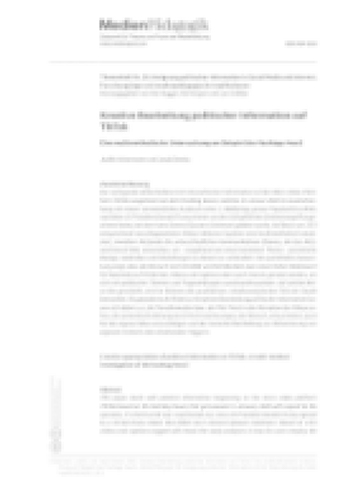Abstract
Open Educational Resources (OER) promise to reduce entry barriers towards educational resources as well as to avoid redundant work when similar educational resources of high quality are created in different organizations. However, adoption of OER faces known challenges, and the ALMS framework provides evaluation criteria for the re-use of OER from a technical perspective. Starting from a self-experiment on OER adoption, novel requirements for OER based on the ALMS framework are defined by taking concepts from software engineering and technical writing into account. Respecting these requirements, two OER projects are reported: First, the creation of a new edition of a textbook under a Creative Commons license is sketched. Second, the development and use of a new software tool, called emacs-reveal, is described. This tool allows to generate HTML presentations with embedded audio explanations, which are suitable for self-study. The generation of HTML from simple text files takes place in a public GitLab infrastructure, increasing the software's ease of use. Students' responses to a questionnaire demonstrate advantages of generated presentations.
References
Andrade, António, et al. 2011. «Beyond OER: Shifting focus to open educational practices». Open Educational Quality Initiative (OPAL). https://oerknowledgecloud.org/sites/oerknowledgecloud.org/files/OPAL2011.pdf.
Atkins, Daniel E., John Seely Brown, und Allen L. Hammond. 2007. «A Review of the Open Educational Resources (OER) Movement: Achievements, Challenges, and New Opportunities». Report to The William; Flora Hewlett Foundation. http://www.oerderves.org/wp_content/uploads/2007/03/a_review_of_the_open_educational_resources_oer_movement_final.pdf.
Auer, Sören, Ali Khalili, und Darya Tarasowa. 2013. «Crowd-sourced Open Courseware Authoring with SlideWiki.org». International Journal of Emerging Technologies in Learning (IJET) 8 (1): 62–63. https://doi.org/10.3991/ijet.v8i1.2539.
Bishop, Jacob Lowell, und Matthew A. Verleger. 2013. «The flipped classroom: A survey of the research». In 2013 ASEE Annual Conference & Exposition, 1–18. https://peer.asee.org/22585.
Chacon, Scott, und Ben Straub. 2014. Pro Git. 2. Apress. https://doi.org/10.1007/978-1-4842-0076-6.
Ehlers, Ulf-Daniel. 2011. «Extending the territory: From open educational resources to open educational practices». Journal of Open Flexible and Distance Learning 15 (2): 1–10. http://www.jofdl.nz/index.php/JOFDL/article/view/64.
Feller, Joseph, Brian Fitzgerald, Scott A. Hissam, und Karim R. Lakhani, Hrsg. 2005. Perspectives on Free and Open Source Software. MIT Press.
Glushko, Robert J. 2015. «Collaborative Authoring, Evolution, and Personalization for a Transdisciplinary Textbook». In Companion to the Proceedings of the 11th International Symposium on Open Collaboration, 10:1–10:10. https:// doi.org/10.1145/2789853.2789867.
Hailperin, Max. 2016. Operating Systems and Middleware – Supporting Controlled Interaction. Revised edition 1.2.1.
Hailperin, Max. 2017. Operating Systems and Middleware – Supporting Controlled Interaction. Revised edition 1.3. https://gustavus.edu/mcs/max/os-book/.
Hefferon, Jim, und Albert Schueller. 2016. «Writing an Open Text». The Mathematical Intelligencer 38 (2). Springer: 6–9. https://doi.org/10.1007/s00283-015-9606-1.
Hilton, John III, David Wiley, Jared Stein, und Aaron Johnson. 2010. «The four ‘R’s of openness and ALMS analysis: frameworks for open educational resources». Open Learning 25 (1). Taylor & Francis: 37–44. https://doi.org/10.1080/02680510903482132.
Jung, Insung, Teruyoshi Sasaki, und Colin Latchem. 2016. «A framework for assessing fitness for purpose in open educational resources». International Journal of Educational Technology in Higher Education 13 (1). https://doi.org/10.1186/s41239-016-0002-5.
Kerres, Michael, und Richard Heinen. 2014. «Open Educational Resources und schulisches Lernen: Das Zusammenwirken von Plattformen für Lernressourcen in informationell offenen Ökosystemen». In MEDIEN – WISSEN – BILDUNG: Freie Bildungsmedien und Digitale Archive, Petra Missomelius, Wolfgang Sützl, Theo Hug, Petra Grell, und Rudolf Kammerl (Hrsg.), 189–210. innsbruck university press. https://www.uibk.ac.at/iup/buch_pdfs/freie-bildungsmedien_web.pdf.
McGee, Monnie, Lynne Stokes, und Pavel Nadolsky. 2016. «Just-in-Time Teaching in Statistics Classrooms». Journal of Statistics Education 24 (1): 16–26. https://doi.org/10.1080/10691898.2016.1158023.
Merkel, Dirk. 2014. «Docker: Lightweight Linux Containers for Consistent Development and Deployment». Linux Journal. 2014 (239). Houston, TX: Belltown Media.
Mruck, Katja, Günter Mey, Sandra Schön, Heiko Idensen, und Peter Purgathofer. 2013. «Offene Lehr- und Forschungsressourcen. Open Access und Open Educational Resources». In L3T. Lehrbuch für Lernen und Lehren mit Technologien, herausgegeben von Martin Ebner und Sandra Schön, 2. Auflage. epubli. https://l3t.tugraz.at/index.php/LehrbuchEbner10/article/view/112.
Novak, Gregor M., Evelyn T. Patterson, Andrew Gavrin, und Wolfgang Christian. 1999. Just-in-Time Teaching: Blending Active Learning and Web Technology. Prentice Hall.
Rockley, Ann. 2001. «The Impact of Single Sourcing and Technology». Technical Communication 48 (2). Society for Technical Communication: 189–93. http://rockley.com/articles/Single_Sourcing_and_Technology.pdf.
Schulte, Eric, und Dan Davison. 2011. «Active Documents with Org-Mode». Computing in Science & Engineering 13 (3): 66–73. https://doi.org/10.1109/MCSE.2011.41.
Shaffer, Clifford A., Thomas L. Naps, und Eric Fouh. 2011. «Truly Interactive Textbooks for Computer Science Education». In Proceedings of the Sixth Program Visualization Workshop, 97–103. https://people.cs.vt.edu/shaffer/Papers/pvw1.pdf.
Siddhi, Desai, Jashin M. Verghese, und Desai Bhavik. 2017. «Survey on Various Methods of Text to Speech Synthesis». International Journal of Computer Applications 165 (6). https://doi.org/10.5120/ijca2017913891.
Stallman, Richard M. 1986. «What Is the Free Software Foundation?». GNU’s Bulletin 1 (1). https://www.gnu.org/bulletins/bull11.html#SEC4.
Thorogood, Miles. 2016. «slideDeck.Js: A Platform for Generating Accessible and Interactive Web-Based Course Content». In Proceedings of the 21st Western Canadian Conference on Computing Education, 13:1–:5. WCCCE’16. New York, NY, USA: ACM. https://doi.org/10.1145/2910925.2910941.
Vukovic, Boris, und Claude Martin. 2009. «Free and open source software (FOSS) and OER: Part I – An introductory note». In Open Educational Resources: Conversations in Cyberspace. UNESCO Publishing, 105-124. https://unesdoc.unesco.org/ark:/48223/pf0000181682.
Wiley, David. 2014. «The Access Compromise and the 5th R». https://opencontent.org/blog/archives/3221.
Zentrum für Hochschuldidaktik (DiZ), ed. 2016. «DiNa 12/2016». https://diz-bayern.de/publikationen/dina/360-2016-dezember-hd-mint-sonderausgabe-wege-zum-verstaendnis-bauen.

